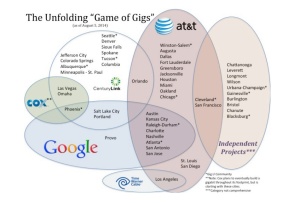If Ohio communities want more investment and economic growth, real competition can be the needed incentive. Competition can also bring other i mmediate benefits. This has played out quite clearly through the events in the broadband industry over the last year. A report released by Gig.U in August, 2014, describes the “Game of Gigs” detailing the impacts of broadband competition to communities in terms of broadband infrastructure investment and economic growth. Even as late as early 2013, large broadband carriers were unwilling to invest in faster broadband networks despite Google Fiber building fiber broadband into Kansas City and working with both Provo, Utah and Austin, Texas. But, quickly on the heels of Google Fiber’s announcement in February 2014 to explore nine more metro areas, carriers like AT&T and Cox start announcing their own plans to invest in their networks to provide gigabit speeds to communities. The image above shows the broadband industry response in just under six months relating to gigabit fiber broadband investments and the growing number of communities that will benefit. Only one community in Ohio, Cleveland, made the list. The report states, ” It’s not an accident that there is a tremendous overlap between where Google is looking at entry and where incumbents are looking at upgrades. It’s not an accident that Comcast, Verizon, and Time Warner have recently announced speed increases, with a focus on communities where gigabit efforts by others are proceeding.”
mmediate benefits. This has played out quite clearly through the events in the broadband industry over the last year. A report released by Gig.U in August, 2014, describes the “Game of Gigs” detailing the impacts of broadband competition to communities in terms of broadband infrastructure investment and economic growth. Even as late as early 2013, large broadband carriers were unwilling to invest in faster broadband networks despite Google Fiber building fiber broadband into Kansas City and working with both Provo, Utah and Austin, Texas. But, quickly on the heels of Google Fiber’s announcement in February 2014 to explore nine more metro areas, carriers like AT&T and Cox start announcing their own plans to invest in their networks to provide gigabit speeds to communities. The image above shows the broadband industry response in just under six months relating to gigabit fiber broadband investments and the growing number of communities that will benefit. Only one community in Ohio, Cleveland, made the list. The report states, ” It’s not an accident that there is a tremendous overlap between where Google is looking at entry and where incumbents are looking at upgrades. It’s not an accident that Comcast, Verizon, and Time Warner have recently announced speed increases, with a focus on communities where gigabit efforts by others are proceeding.”
The broadband industry recognizes that the entrance of Google Fiber into the broadband market, along with other independent efforts, is putting pressure on the existing incumbents to change the old competitive duopoly (e.g,, AT&T and Time Warner Cable) into a real competitive marketplace. But some suggest that the race by incumbents to announce broadband improvements could be nothing more than marketplace theatrics, or a “Fiber to the Press Release” hype:
What AT&T, CenturyLink, Cox and others are doing is putting on a stage play — designed to give the illusion they’re on the cutting edge of broadband competition.
There are still millions of broadband users without real competition and still suffering with slow DSL or expensive cable broadband. The announcements are not backed up by many capital investment plans and could be in limited areas within each community announced. However, it is clear that without competition, there is little to no incentive for the incumbents to provide higher speeds or invest in new technology.
So, why does real broadband competition matter to Ohio? There are many benefits to competition, like:
Over the next several posts, we will provide recent examples where communities have experienced these benefits. There are also several obstacles to real broadband competition, along with lessons communities have learned to create better incentives for broadband competition.
Leigh Sandy is the founder of Extra Mile Fiber and has been building and operating networks connected to the Internet since 1995.
